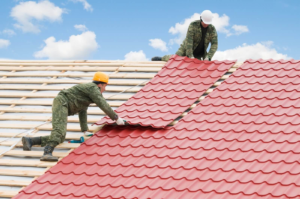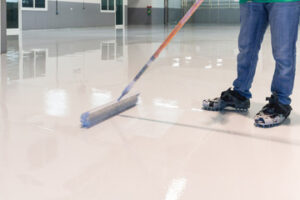There are many different roofing materials and styles to suit your personal style. Roofs are constructed of rafters or prefabricated trusses, with sheathing to protect the underlying layers.
A gutter system carries rainwater away from the roof to minimize erosion and foundation damage. A drip edge is a metal flashing installed along the edges to control the direction of dripping water. Click https://arthursconstructionnc.com/ to learn more.

There are a variety of roofing materials available, from natural products like thatch and slate to asphalt shingles, tile, metal shakes or shingles and concrete tiles. Each material has its own benefits and drawbacks, but the choice of which one to use should depend on a number of factors, including cost, durability and weather conditions in the area where you live.
There is also a number of newer roofing technologies that are now available, such as reflective shingles and eco-friendly roofs. These can not only improve your home’s energy efficiency but can add significant value to it as well.
Slate is a popular natural roofing material. It is highly durable and long-lasting, but can be quite expensive. It is typically laid in overlapping layers and can be secured with metal or wooden nails. It can withstand heavy snow loads, but is susceptible to water intrusion and ice dams in colder climates.
Clay tile is an alternative to slate roofing and can be very affordable if you get a good deal on it. It is a sturdy option that can withstand extreme weather conditions and comes in a range of colors. Concrete tiles are heavier than clay and can require more maintenance due to their tendency to absorb water, but they also come in a variety of designs that can help make a home stand out on the block.
Felt underlayment is another common roofing material. It is a secondary layer that protects the roof deck from moisture and offers some fire resistance. It is usually available in 15 lb or 30 lb weights and can be self-adhered or covered with a sticky backing to offer better waterproofing. It is often recommended in high-risk areas alongside an ice and water shield to minimize leaks.
BUR or built-up roofing is a durable membrane that is suitable for flat roofs. It consists of multiple layers of felt or other fabric with bitumen (typically coal tar or petroleum) between them. This type of roof can withstand punctures and tears and is also resistant to chemicals, bacterial growth and standing water. In addition, it is heat-resistant and can help lower your energy costs.
Installation
Roofing is an essential component of any building. It serves as the main barrier against the weather, and helps to preserve the structure and keep indoor spaces comfortable. The installation process is complicated and requires specialized skills and equipment. The first step is preparing the site. This involves covering landscaping and other structures with tarps to protect them from falling debris during the construction process. It is also important to make sure that the work area is clean and free of obstructions.
Once the roof is prepared, it is time to begin construction. The roofing team will start by removing any existing material. This can be a noisy and messy process, but it is necessary to ensure that the new roof will be properly installed. Once the old materials are removed, the roofers will lay underlayment and felt paper. These materials help to waterproof the roof and prevent moisture damage to the interior of the home.
After the underlayment and felt paper are in place, the roofers will install shingles. They will overlap each row by about six inches and nail them in a pattern that starts with close nails along the edge and then spreads out towards the middle. They will also waterproof the valleys of the roof, which are the areas where the slopes meet.
Depending on the type of roof, the roofers may also install vents or ridge caps. These are used to protect the eaves, as well as help with attic ventilation and energy efficiency.
Maintenance
Roofs require regular maintenance to protect interiors, prevent leaks and damage, and prolong the life of a roofing system. In some cases, failure to perform routine maintenance can result in a shortened roof life and early deterioration of the roofing system which may impact the warranty coverage.
A maintenance procedure should include regular inspections of the entire roof with a particular focus on areas that are susceptible to water penetration, such as vents and flashings. These inspections should be done by a trained roof professional and documented.
This will ensure that any problems are identified promptly and the appropriate action is taken to resolve them. Regular inspections also allow a roof to be maintained in a healthy state, with any deterioration or damage addressed and repaired prior to significant deterioration of the surface or subsurface materials.
The regular inspections should include a comprehensive evaluation of the condition of a roof, including the roof covering, decking and underlayment, flashings, drains, insulation, vapor barriers, trusses and beams, and other structural components. In addition, all components of the roofing system should be closely inspected to identify any physical damage and determine whether the repair can be made at that time or whether further investigation is required.
In addition, any debris that has accumulated on the roof should be removed immediately. This includes loose gravel, dirt and twigs that retain moisture on the roof membranes, promote growth of algae and mold, and can cause ponding that can prematurely deteriorate the roofing system. It is also important to inspect all field and auxiliary drains for blockage, which can also result in excessive moisture on the roof membrane and underlying structures.
Finally, any safety issues that could be a risk to the maintenance staff should also be addressed by a professional. This should include a review of stairs, crossovers, platforms and railings for structural soundness and deterioration, especially around areas that contain electrical, hot equipment or pipes. It should also include a comprehensive review of all signage on the roof, to make sure it is legible and clearly indicates any hazards that are present.
Re-roofing
There are a number of reasons why people may choose to re-roof their homes. One major reason is that it can be cheaper than a full roof replacement. Another is that it can add value to the home and make it easier to sell in the future. Finally, re-roofing can also help to fix small problems with the roofing system and extend its lifespan. It is important to note, however, that re-roofing is not ideal in every situation. The decision between re-roofing and roof replacement should be based on the age and condition of the existing roofing system.
If the shingles are nearing the end of their life or have sustained serious damage, a complete roof replacement is likely to be needed in order to prevent leaks and other issues. Re-roofing can be a good choice in these cases, but it isn’t typically a long-term solution.
Many cities and towns have laws in place that limit the amount of layers a residential roof can have. Adding an additional layer of shingles can cause significant structural issues, especially if the old shingles are already thin. Moreover, the weight of the new shingles can put too much strain on the roof structure and can lead to a weakened and unsafe roof.
For these reasons, it’s important to talk with a roofing contractor about whether re-roofing is an option for your home. A professional can help you understand the advantages and disadvantages of re-roofing versus a complete roof replacement, and they can help you make an informed decision based on your needs and the law in your area.
Often, a re-roofing project will be done using an overlay technique that involves putting a new layer of shingles on top of the old ones. This method is less expensive than a tear-off but it is not a permanent solution and can make it harder to track down leaks. In addition, re-roofing may void any warranty or guarantee that came with your original roofing materials. If you have a metal roof or flat roof, this may not be an issue, but homeowners should check with their local building codes and regulations before opting for this option.

